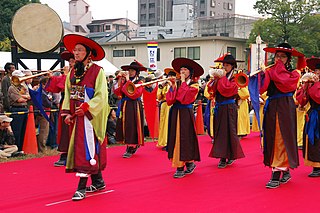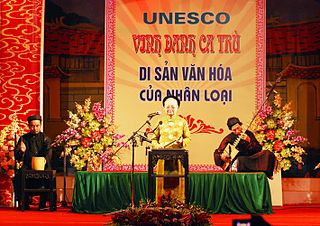
The United States' multi-ethnic population is reflected through a diverse array of styles of music. It is a mixture of music influenced by the music of Europe, Indigenous peoples, West Africa, Latin America, Middle East, North Africa, amongst many other places. The country's most internationally renowned genres are traditional hipop , jazz, blues, country, bluegrass, rock, rock and roll, R&B, pop, hip-hop/rap, soul, funk, religious, disco, house, techno, ragtime, doo-wop, folk, americana, boogaloo, tejano, surf, and salsa, amongst many others. American music is heard around the world. Since the beginning of the 20th century, some forms of American popular music have gained a near global audience.
A roots revival is a trend which includes young performers popularizing the traditional musical styles of their ancestors. Often, roots revivals include an addition of newly composed songs with socially and politically aware lyrics, as well as a general modernization of the folk sound.
The music of Greece is as diverse and celebrated as its history. Greek music separates into two parts: Greek traditional music and Byzantine music. These compositions have existed for millennia: they originated in the Byzantine period and Greek antiquity; there is a continuous development which appears in the language, the rhythm, the structure and the melody. Music is a significant aspect of Hellenic culture, both within Greece and in the diaspora.
Music of Kazakhstan refers to a wide range of musical styles and genres deriving from Kazakhstan. Kazakhstan is home to the Kazakh State Kurmangazy Orchestra of Folk Instruments, the Kazakh State Philharmonic Orchestra, the Kazakh National Opera and the Kazakh State Chamber Orchestra. The folk instrument orchestra was named after Kurmangazy Sagyrbayuly, a well-known composer and dombra player from the 19th century.

Korea has produced music for thousands of years, into the modern day. After the division of Korea in 1945, both North and South Korea have produced their own styles of music.

Traditional Vietnamese music encompasses a large umbrella of Vietnamese music from antiquity to present times, and can also encompass multiple groups, such as those from Vietnam's ethnic minority tribes.

African-American music is a broad term covering a diverse range of musical genres largely developed by African Americans and their culture. Its origins are in musical forms that developed as a result of the enslavement of African Americans prior to the American Civil War. It has been said that "every genre that is born from America has black roots."

Pansori is a Korean genre of musical storytelling performed by a singer and a drummer.

K-pop, short for Korean popular music, is a form of popular music originating in South Korea. It includes styles and genres from around the world, such as pop, hip hop, R&B, rock, jazz, gospel, reggae, electronic dance, folk, country, disco, and classical on top of its traditional Korean music roots. The term "K-pop" became popular in the 2000s, especially in the international context. The Korean term for domestic pop music is gayo, which is still widely used within South Korea. While "K-pop" can refer to all popular music or pop music from South Korea, the term is often used when referring to artists associated with the entertainment and idol industry in the country, regardless of the genre of music output.
Trot is a genre of Korean popular music, known for its use of repetitive rhythm and vocal inflections. Originating during the Japanese occupation of Korea in the first half of the 20th century, trot was influenced by many genres of Korean, Japanese, American, and European music.
Italian popular music is musical output which is not usually considered academic or classical music but rather has its roots in the popular traditions, and it may be defined in two ways: it can either be defined in terms of the current geographical location of the Italian Republic with the exceptions of the Germanic South Tyrol and the eastern portion of Friuli-Venezia Giulia; alternatively, it can be defined as the music produced by all those people who consider themselves as Italians and openly or implicitly refer to this belief. Both these two definitions are very loose: due to the complex political history of the Italian Peninsula and the different independent political states, cultural and linguistic traditions which sprang within them, it is rather difficult to define what may be considered to be truly Italian. Since before the formation of a unified educational system and the spread of information through the radio and the press during the 1920s, all the different cultural and linguistic groups within the country were independent of one another, and a unified Italian country was still only a political or ideological concept far from the daily life.
Popular music is music with wide appeal that is typically distributed to large audiences through the music industry. These forms and styles can be enjoyed and performed by people with little or no musical training. As a kind of popular art, it stands in contrast to art music. Art music was historically disseminated through the performances of written music, although since the beginning of the recording industry, it is also disseminated through recordings. Traditional music forms such as early blues songs or hymns were passed along orally, or to smaller, local audiences.

Song So-hee, widely known as the "Traditional Music Girl" is a South Korean Gyeonggi minyo or traditional folk singer. She rose to fame after winning the KBS National Singing Contest in 2008 at the age of 11, earning her a reputation as a gugak prodigy. The South Korean government honored Song with the title, "Best Korean of the Year," in 2010.
Korean ballad, also known as K-ballad, is a style of music in South Korea and a genre in which soul and rhythm and blues music is transformed to suit Korean sentiment. It became popular in the 1980s, and has influenced and evolved into many different music styles.
"Monggeumpo Taryeong" is a representative Korean folk song of the northwestern areas of the Hwanghae and Pyeongan provinces of North Korea. The song describes the lives of local fishermen and the surrounding port, village, hills, and scenery. The song is about lovers in a beautiful harbor who wait and sing for the return of their loved ones, who are sailors.








